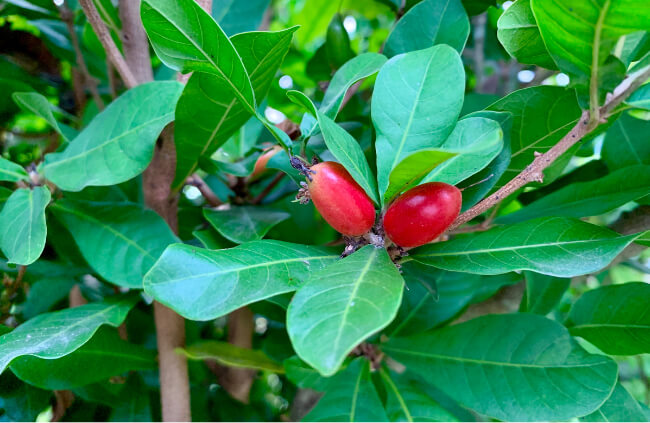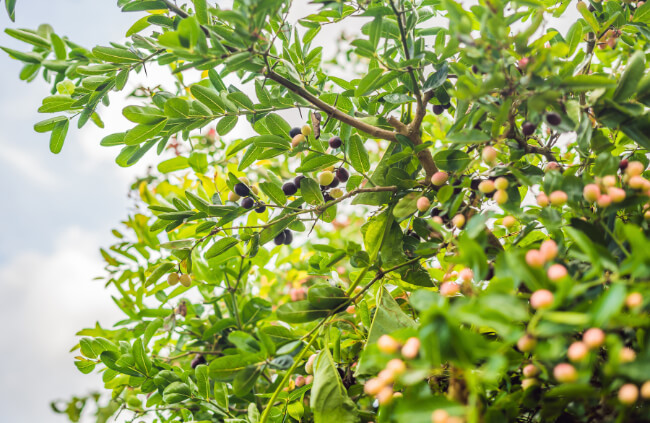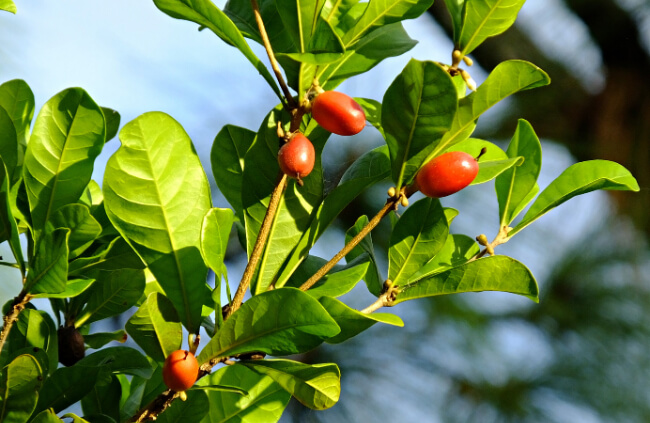The first seeds of miracle fruit arrived in Australia in 1978. I love how appropriate the name miracle berry is, considering its use for people who are receiving diabetic treatment or chemotherapy.
These patients often suffer from a lack of taste due to their treatment, or end up with a metallic taste in their mouth. Miracle berries are being used to improve food taste and ultimately, promote a better appetite.
In our guide, we’ll share how to propagate miracle fruit using seeds, how to care for this shrub or small tree from watering to soil needs, and share some insight into the culinary use of miracle fruit and how to store it once harvested.
More...

Family: | Sapotaceae |
|---|---|
Genus: | Synsepalum |
Species: | S. Dulcificum |
Common Names: | Miracle Fruit, Miracle Berry, Miraculous Berry |
Origin: | West Africa |
Location: | Indoor and outdoor |
Type: | Shrub, small tree |
Growth: | Up to 1.8 metres tall and 92 cm wide |
Sun requirements: | Filtered sun, partial shade |
Foliage Colour: | Green |
Flower Colour: | White |
Flowering: | Throughout the year |
Edible Parts: | Fruit (red or pink berries) |
Maintenance level: | Moderate |
Poisonous for pets: | Rather be cautious as there is limited research |
Introducing the Miracle Berry Plant
Synsepalum dulcificum is a plant indigenous to West Africa. The more common names like miracle fruit and miracle berry, actually come from miraculin, the protein or active ingredient in the fruit that is responsible for altering sour flavours and making them sweeter when eaten.
Miraculin binds to your taste buds and changes how the taste of a sour food is interpreted by the brain. Miracle fruit is small and similar to the size of a cranberry. The miracle berry can either grow as a shrub or smaller tree in terms of size and shape.
It has oval leaves that grow in clumps at the end of the plant’s branches and produces tiny white flowers followed by red fruit.
Benefits of the Miracle Fruit
Miracle fruit is packed with vitamin C, K, A, and E. It’s also rich in amino acids. The health benefits of eating the fruit are regulating blood sugar, stronger immunity, and better vision.
How to Grow Miracle Berry in Australia
In order to propagate your own miracle berry, this is best done using seed. You’ll need a potting mix that is rich and well-draining. The seeds you use need to be as fresh as possible.
Once the seed has been exposed to air, it begins to dry out and after a day or two, won’t be viable. When you plant the miracle fruit seeds, remove the flesh and then just lightly cover the seeds with the potting mix.
You can give the seeds a light watering on alternate days. The miracle fruit seedlings need to be kept moist and warm until they germinate.

Source: Fast Growing Trees
Germinating Miracle Berry Seeds
Miracle berry seeds usually take around 8 weeks to germinate. Their growth is slow for the first year and it’s not abnormal for a new plant to be around just 7 cm in height after year one.
We recommend that you keep your miracle berry seedlings in pots until they reach a height of at least 35 cm. You can repot them each year until they reach this height, and then they’ll be ready for the garden.
After around 4 years, it will start to grow more quickly. You can expect the plant to start producing fruit around the 3 to 4 year mark. Other methods of propagation like air layering or using cuttings aren't impossible but are more complex.


Get Your Free Guide:
Master Growing Australian Natives eBook
A Must Have Complete Guide for Every Australian Garden
Get Your Free Guide:
Master Growing Australian Natives eBook
A Must Have Complete Guide for Every Australian Garden
Cuttings tend to take longer to root themselves and they don’t grow as quickly. In fact for commercial purposes, miracle berries are still propagated using seed.
Ideal Conditions for Growing Miracle Berries
Light
Synsepalum dulcificum benefits from bright light which helps to improve growth rate. In hotter temperatures, rather keep your miracle berry in shade with no direct sun exposure. For cooler temperatures, you can go for partial shade.
Soil
Miracle fruit needs a moist and well-draining soil which is very acidic. Aim for a pH of 4.0 to 5.0. Good air circulation and moisture is important. If the soil is drying out too quickly, you can add more organic matter such as compost or coconut coir. If it’s staying too wet, you can add extra perlite which helps the soil to dry quicker.
Temperature
Miracle berry is usually classified as a tropical fruit. It does however grow well in a sub-tropical garden and can handle lower temperatures in the cooler seasons if it’s well protected.

How to Care for Miracle Fruit Trees
Watering Schedule
If you’re growing a miracle berry in the ground, you can give it water twice per week while it’s still in the first growing period. When the miracle berry has established itself, the rain should provide enough water.
The plant is considered drought tolerant. For miracle berries grown in a pot, you can water the plant twice a week during the first year. Thereafter, you’ll need to water more often as the plant grows.
For miracle fruit that is grown outside, you can use organic mulch around the root area of the plant. This will help to keep the moisture in.
What Fertiliser to Use
You can fertilise your miracle berry during spring or autumn using a slow release fertiliser. You can also feed the plant a little bit of organic fertiliser every 3 months, just on top of the soil.
Adding some iron sulphate to the fertiliser helps the growth of the miracle fruit.
Pruning Needs
You don’t need to do much pruning for the miracle berry. They grow well with almost no pruning and keep a small size even when established. If you want to shape your plant accordingly, try not to over prune.
Harvesting and Storing Miracle Berries
When to Harvest Miracle Berries
Synsepalum dulcificum is ideally harvested between May and October, but you can in fact harvest the fruit throughout the year. Miracle fruit skin changes from green to a bright red when it becomes ripe. The flesh is pink, and the berry has a single seed.
Miracle berries can perish quickly and once you pick them, they only last around 3 days. This depends on temperature as well. You can eat the fruit raw or otherwise freeze as soon as possible.

How to Store Miracle Berries
You can store it for up to 4 weeks in the freezer and the fruit doesn’t lose its quality. You can therefore pick some fruit as it becomes ripe and then just freeze straight away so you can enjoy it over the next few days.
The miraculin protein in miracle fruit might not work as long as usual if it’s eaten with a meal that is very hot in terms of temperature, or if it’s very acidic. Miracle berry plants can start producing fruit from around 4 years of age.
The fruit also matures quickly, in a period of 4 weeks from the first appearance to fully ripe.
Common Miracle Fruit Pests and Diseases
Scale
Signs that your miracle berry is under attack from scale is a black and sticky type of coating on the leaves. You might also find it on the branches. Leaves that are yellow or that look unwell are also a sign, along with ants.
Mealybugs
Signs of mealybugs to look out for are a type of white looking cotton on the leaves, leaves that look waxy or sticky with honeydew, and the presence of black sooty mould.
If the infestation of mealybugs is big enough, it can slow down the growth of your miracle fruit plant and start causing the leaves to fall off.
Mites
When your plant is dealing with unwelcome mites, you’ll notice brown and wilting leaves, leaves that are curling and yellow, specks on the leaves, and little webs. The leaves might also start to drop off.
In the case of any of the above pests, you can use an application of neem oil and spray it straight onto the pests. You’ll need to follow up with two more treatments and you can do them about two weeks apart.
Miracle Fruit Tree Frequently Asked Questions

Source: Gardenstead
What are the special features of miracle fruit?
The fruit contains a type of protein called miraculin. This protein attaches itself to your taste buds and influences the sweet receptors on your tongue. Some parts of the miracle berry plant are packed with flavonoids and terpenoids.
These phytochemicals provide potential health benefits such as lowering cholesterol, and being used as an anticonvulsant..
What are the uses and benefits of miracle berry?
It’s used as a food colourant for sugars and also for fizzy drinks. From a medicinal point of view, miracle fruit can help to treat diabetes as a sugar free and low calorie alternative.
What are the other species that also have the name miracle berry?
Gymnema sylvestre and Thaumatococcus daniellii. These fruits are also used to increase sweetness in foods. The Hindi name for Gymnema sylvestre is gurmar and it means “destroyer of sugar”.
The plant is native to India and the leaves are used for medicinal purposes to limit the amount of sugar absorbed from the intestine. The fruit also increases the production of insulin.
Thaumatococcus daniellii is a species from Africa and contains thaumatin. This is an incredibly sweet protein which acts in the same way as miraculin in miracle berry fruit, binding to the taste buds and creating a sweet taste.
What is the difference between the two species of Synsepalum that produce miracle fruit?
Synsepalum dulcificum has small and narrow leaves, and it grows slowly. Synsepalum subcordatum, which is also called Giant Miracle Fruit, has bigger leaves and eventually becomes a small tree.
It produces bigger fruit and is also a more generous producer of fruit during its first couple of years. Over time, both species will produce the same amount of fruit.
How long does the effect of the miraculin last when eating miracle fruit?
The average time the sour to sweet transition is experienced is around 30 minutes which is more or less the time taken for the saliva to wash away the protein.
Does miracle berry have any side effects?
Eating the fruit can change the pH balance of your blood and increase acidity levels.
Sign up for our newsletter to get more info about other plant types that are both good looking and nutritious.
Wrapping Up Our Miracle Berry Guide
Being able to grow and harvest your own miracle berries at home might feel like a culinary superpower. The ability to change sour flavours to sweet is great, especially if you are watching your sugar levels. You can grow it in a pot if you like, and keep it inside or outside.
Miracle berry is drought tolerant which contributes to its ease of care. On top of all these appealing qualities, the bright colour of the berries are rather beautiful among the green leaves.
Published on August 14, 2023 by Maisie Blevins
Last Updated on February 24, 2024




